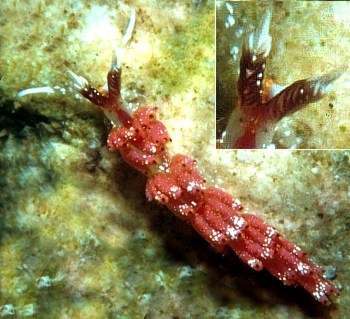
Favorinus mirabilis
Baba, 1955
Order: NUDIBRANCHIA
Suborder: AEOLIDINA
Family: Glaucidae
DISTRIBUTION
First described from Japan and reported here from the Marshall Islands, Guam, Singapore and Mayotte (Indian Ocean).
PHOTO
Specimens from the Marshall Ids showing colour variation. All less than 10mm long. PHOTOS: Scott Johnson.
First described from Japan from a cream coloured specimen similar to the bottom right photo. Baba's specimen had black perfoliate rhinophores, yellow oral tentacles and a yellow margin to the leading edge of the foot. In his painting there is a reddish median line on the head. Scott Johnson's photos suggest that there is some variability in the colour details in this species but that the purple spot and white speckling on the cerata are very consistent.
See Favorinus cf. mirabilis for an animal with orange-yellow cerata, and feeds on Hexabranchus eggs.
-
Baba, K. (1955) Opisthobranchia of Sagami Bay. Supplement. Iwanami Shoten, Tokyo.
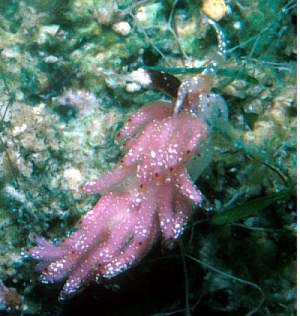
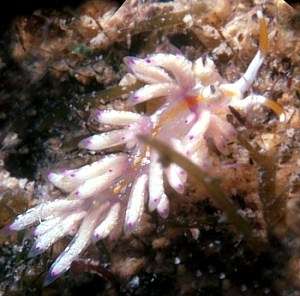
Rudman, W.B., 1999 (December 5) Favorinus mirabilis Baba, 1955. [In] Sea Slug Forum. Australian Museum, Sydney. Available from http://www.seaslugforum.net/find/favomira
Related messages
Favorinus mirabilis feeding
November 24, 2009
From: Mirjam Broos

Dear Bill,
We found this nudibranchs while diving Lobster wall in Mabul. I guess they belong to the genus Favorinus. Can you help me out.
Locality: Mabul, Lobster wall, Sabah, Malaysia, 27 september 2009. Photographer: Geert Prast.
greetings,
Mirjam
mirjam.broos@planet.nl
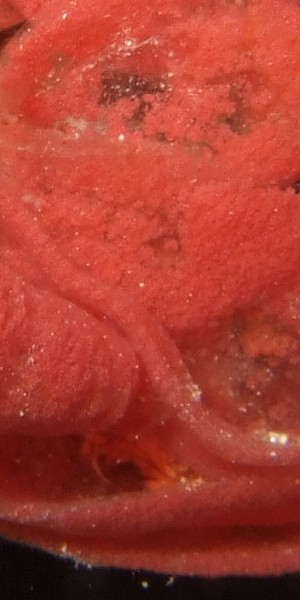
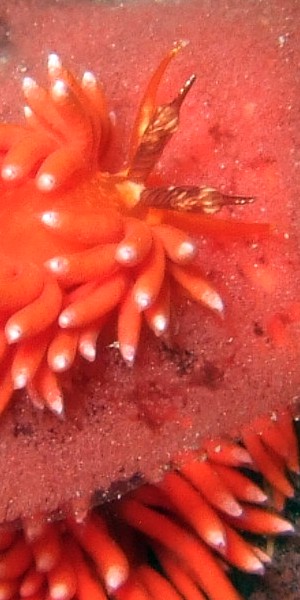
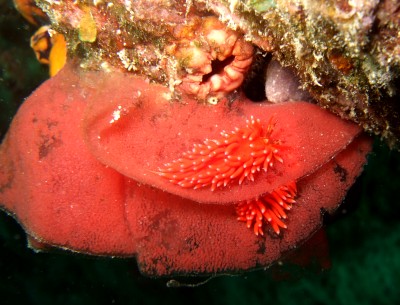
Dear Mirjam,
In an earlier set of messages from Marina Poddubetskaia [#11646] we discussed whether this large orange-red animal is a colour form of Favorinus mirabilis or not. The only real difference has been the lack of a small purple spot just down from the tip of the cerata in most specimens. I have kept these 'spotless' animals separate as Favorinus cf. mirabilis but have always felt they were just large specimens of F. mirabilis. If you look carefully at your animals I can definitely see the purple spot on some cerata so am fairly confident that these are large Favorinus mirabilis Their colour is derived from the egg-ribbon they are feeding on food, which I suspect is that of Hexabranchus sanguineus.
Best wishes,
Bill Rudman
Re: Favorinus mirabilis from Red Sea
March 17, 2008
From: Binyamin Koretz
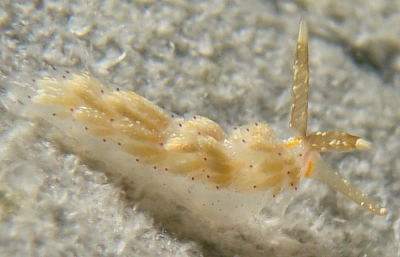
Concerning message #13273:
Dear Bill,
In the years since Oren first photographed what you called Favorinus sp. 7, it's become a common visitor in the late winter to early spring when the Eilat coastline gets inundated with filamentous algae. They are generally in the 6 to 8 mm range.
This year we upgraded our photographic ability with a macro lens (actually 2) and we were able to document the species a lot more clearly. The accompanying photographs were taken with the animal crawling on my glove, as it was not possible to get satisfactory results in the algae.
Having seen the details, I was wondering whether this species would fall within the variability of Favorinus mirabilis. What do you think?
best regards
Binyamin
Locality: Eilat, Tables South, 18 m, Israel, Red Sea (Gulf of Eilat), 22 February 2008, sandy slope, some corals, all covered with filmentous algae. Length: 6 mm. Photographer: Binyamin and Shulamit Koretz.
binyamin@koretz.net
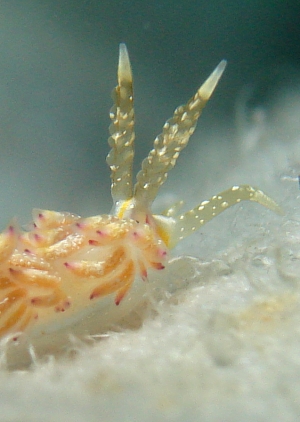
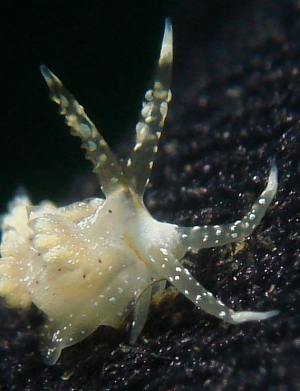
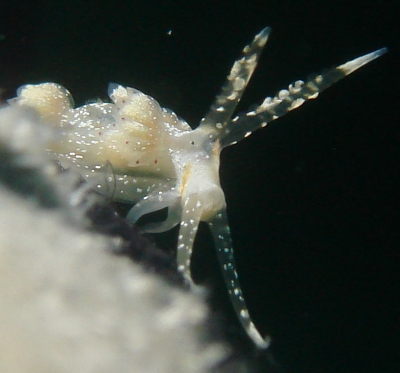
Dear Binyamin,
Yes from these nice photos I think it is pretty clear that this is F. mirabilis. So we no longer need Favorinus sp. 7. It is interesting to note the yellow mark on each side of the head - something we don't normally see in photos taken from above.
Best wishes,
Bill Rudman
Favorinus mirabilis from Moorea
July 8, 2006
From: Seabird McKeon
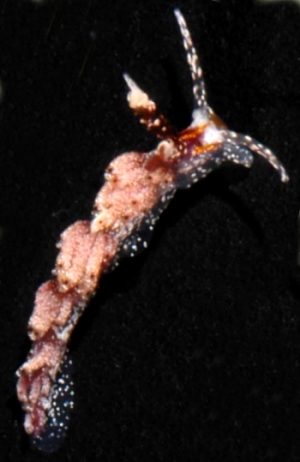
Dear Bill,
I'm here in Moorea, French Polynesia assisting Dr. Gustav Paulay with his biodiversity surveys of the island. On a recent trip to the rubble beds immediately behind the reef crest, in about 1.5m of water, I found a small nudibranch (aeolid?). We were hoping that you might recognize it.
Locality: Moorea, 1.5m, French Polynesia, Pacific, July 3, 2006, Acropora rubble. Length: 5mm. Photographer: Gustav Paulay.
Cheers,
Seabird McKeon
mckeons@ufl.edu
McKeon, C.S., 2006 (Jul 8) Favorinus mirabilis from Moorea. [Message in] Sea Slug Forum. Australian Museum, Sydney. Available from http://www.seaslugforum.net/find/17072Dear Sea,
I am glad to say this is one of your Moorea collection I can put a definite name to. This is Favorinus mirabilis which belongs to an interesting genus of aeolid nudibranchs which feed, not on cnidarians, but the eggs of other sea slugs. Most records on the Forum have it feeding on Hexabranchus eggs but I don't know if feeds only on those or is happy with a wider variety of eggs.
Best wishes,
Bill Rudman
Favorinus mirabilis from Singapore
April 23, 2005
From: Lim Han Peng

Hi Bill,
will like to know is this a Flabellina rubrolineata?
Locality: Pulau Hantu, Singapore, South China Sea. Depth: 11 m. Length: 15 mm. 26 March 2005. Sandy bottom. Photographer: hp lim
H.P.Lim
limhp@hotpop.com

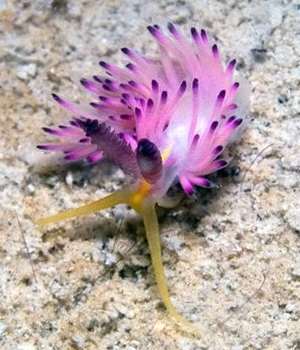
Dear hp,
I am pretty sure this is another colour form of Favorinus mirabilis. In some ways it is very close to the original painting (Baba, 1953), in which the whole of the oral tentacles are yellow. The yellow line down the midline of the head, between the rhinophores, is unusual, but many of the photos already on the Forum show a coloured line down the midline like this.
Best wishes,
Bill Rudman
Favorinus? from Red Sea
March 5, 2005
From: Oren Lederman

Note added 14 March 2008: This is Favorinus mirabilis - see message #21432.
Hi Bill,
Here's another one we couldn't identify. The photos of two animals were taken during a night dive, and the photo of the single animal was taken during a early morning dive.
Locality: Near the "Yetush" shipreck ,Eilat Bay, Israel, Red Sea. Depth: ~22 m. Length: 0.5 cm. 18 Feb 2005. Photographer: Oren Lederman
In some photos you can clearly see the "front" of one of them. Notice the double "horns" and yellow line between them.
Oren Lederman
lederman@bigmail.co.il
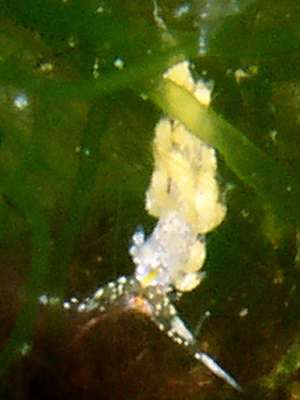

Dear Oren,
This is quite interesting. It is an aeolid nudibranch and the distinctive colours of the head tentacles [rhinophores, oral tentacles], and the yellow median line on the head are very distinctive. I can't think of a species with that colour pattern so you may have found an unnamed animal. From its general shape I wouldn't be surprised if it was a species of the egg-eating genus Favorinus. Another point in favour of that idea is that species of Favorinus are quite often found in such habitat, crawling around in tangled algal beds, I suspect because it is a good place for other nudibranchs to lay their egg ribbons.
Best wishes,
Bill Rudman
Favorinus mirabilis from Mayotte
December 15, 2003
From: Marina Poddubetskaia
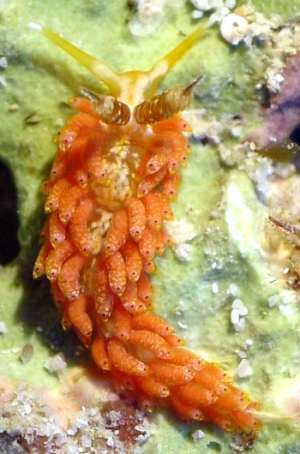
Dear Bill,
Here is a record of Favorinus mirabilis from Indian Ocean. Many specimens of this species were found on an a Hexabranchus egg-ribbon. The biggest guy was 15mm in length. So, it seems to be a tiny species.
I moved these specimens to better photograph them.
But also there were many specimens of Favorinus cf. mirabilis on the same egg-ribbon [see message #11580]. Photos of both species together on the egg ribbon are in message #11646.
Date: November 14, 2003
Location: Mayotte Island, France, Indian Ocean
Site: Choizil
Depth: 19m
Size : Upper: 15mm., Lower Left: 13mm., Lower Right: 8mm
Cordially,
Marina.
nembro@nembro.info
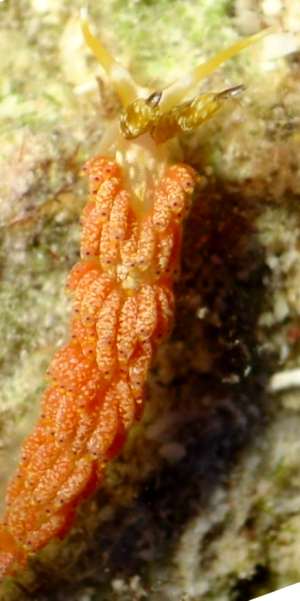


Dear Marina,
Thanks for these thought provoking photos. The small animals in the attached photos are clearly Favorinus mirabilis with the very characteristic subterminal purple spot on the cerata.
The size difference between these typical animals and the Favorinus cf. mirabilis you found at the same time might reflect a real maximum size difference or it could reflect the time the larvae arrived on the egg ribbon. That is the larvae of 'typical' Favorinus mirabilis arrived later and so the animals haven't had time to grow as large. This doesn't of course explain the absence of the purple spot in the larger animals. I think we will need to look at their anatomy.
Best wishes
Bill Rudman
Favorinus mirabilis and Favorinus cf. mirabilis
December 15, 2003
From: Marina Poddubetskaia
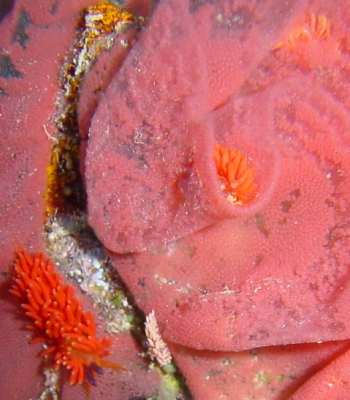
Dear Bill,
Here are some photos to accompany my messages on Favorinus cf. mirabilis see message 1) and Favorinus mirabilis see message 2) on the same Hexabranchus egg ribbon.
As you can see in the photos both typical Favorinus mirabilis and Favorinus cf. mirabilis were found together. And they really look like two distinct species.
• Favorinus cf. mirabilis can be twice larger in length than Favorinus mirabilis
• the coloration of the body, cerata and rhinophores is very different too
Also, I've seen an egg-mass on this ribbon (visible in centre right photo), but it is impossible to say to which variant / species it belongs to.
Date: November 14, 2003
Location: Mayotte Island, Indian Ocean
Site: Choizil
Depth: 19m
Cordially,
Marina.
nembro@nembro.info
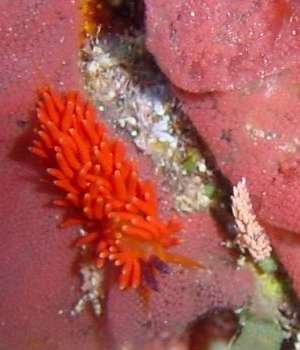

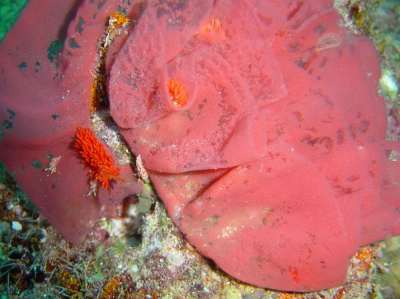
Dear Marina,
I have added some close-ups of your egg ribbon photo to show some of the interesting features.
Upper Right Photo: In the lower left corner we can see 2 small pale F. mirabilis and a large orange F. cf. mirabilis. In the upper right quarter of the photo, parts of 2 or perhaps 3 other specimens of F. cf. mirabilis can be seen nestled in the egg ribbon which they are eating. All over the ribbon cavities sowing eaten out bits of the ribbon are clearly visible.
Centre Left Photo: Showing size difference between the two species
Centre Right Photo: Unidentified white egg ribbon in upper right of photo. Probably from one of these 2 species of Favorinus
Best wishes
Bill Rudman
Favorinus mirabilis from Guam
December 9, 1999
From: C. Carlson & P. J. Hoff
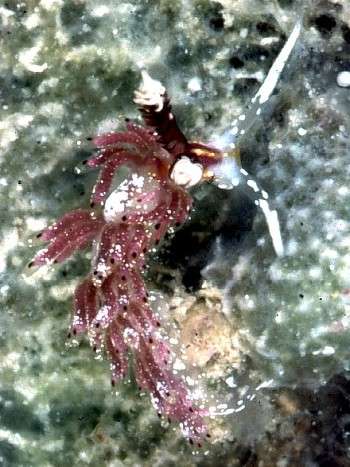
Bill,
Here are some photos of colour variation in Favorinus mirabilis from Guam.
UPPER RIGHT: 8mm; Guam, Bile Bay, 5m; 26 February 1977.
LOWER LEFT: 9mm; Guam, Apra Harbor, 21m; 11 February 1997
LOWER RIGHT: 8mm; Guam, Apra Harbor, 21m; April 1998, leg. Lisa Kirkendale
All photos C. Carlson & P.J. Hoff
The set makes a good example of the results of different coloured egg masses.
Clay & Patty Jo
Merizo, Guam
clay.carlson@kuentos.guam.net

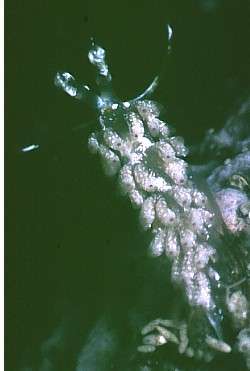
Dear Clay & Patty Jo,
From your photos it looks like the rhinophore clubs range in colour from white to black.
Best wishes,
Bill Rudman.
Re: About Favorinus mirabilis
December 5, 1999
From: Scott Johnson

Hi Bill,
In response to Francisco's question, here are some photos. Although they don't quite match the color of Baba's original description, I've been calling these three animals (E215) Favorinus mirabilis here in the Marshall Islands. If these are indeed all the same species, it is obvious that there is some color variation. They are small, usually less than 10mm in length. Unfortunately, I don't have anything closer of the rhinophores, but they do appear heavily perfoliate.
Scott
johnson@kmr.ll.mit.edu


Dear Scott,
Thanks again for filling the gap! If you ignore the colour of the digestive gland contents in the cerata, which I guess is dependent on the colour of the eggs they have been feeding on, your three animals seem to be fairly consistent in colour except for the white rhinophore clubs in the white animal. They all have white speckling on the ceratal wall, a red or purple spot below the ceratal tip, and a orange or yellow longitudinal band down the midline of the head and the body.
They certainly look like Rie's photo from Japan, and pretty much confirm that it is Favorinus mirabilis.
Bill Rudman.
Rudman, W.B., 1999 (Dec 5). Comment on Re: About Favorinus mirabilis by Scott Johnson. [Message in] Sea Slug Forum. Australian Museum, Sydney. Available from http://www.seaslugforum.net/find/1639About Favorinus mirabilis
December 3, 1999
From: Francisco J. García
Dear Sir
I would like to know if the species Favorinus mirabilis is described with the rhinophores perfoliated (Baba 1955; Willan, 1983) or if have been found specimens with other type of ornamentation. In this way, could you send me references where these aspects or other anatomic features of F. mirabilis have been published?
Thanks in advance
Francisco J. García
fjgarcia@cica.es
Garcia, F.J., 1999 (Dec 3) About Favorinus mirabilis. [Message in] Sea Slug Forum. Australian Museum, Sydney. Available from http://www.seaslugforum.net/find/1633Dear Francisco,
The only reference I know to this species is Baba's original description in the 1955 supplement to Opisthobranchia of Sagami Bay. I am not sure of your reference to Willan 1983.
Baba describes the rhinophores as being 'distinctly perfoliate' and shows it in both the coloured painting and the black & white drawings. The rhinophores are very dark brown. He describes the general body as 'whitish' and cerata as being 'brownish'. The distinctive colour features would appear to be a purple spot near the tip of each ceras and yellow oral tentacles and a yellow margin to the foot.
If anyone has a photo of this animal, or further information, it would be welcome.
Best wishes,
Bill Rudman.
Favorinus from Japan
November 25, 1999
From: Rie Nakano
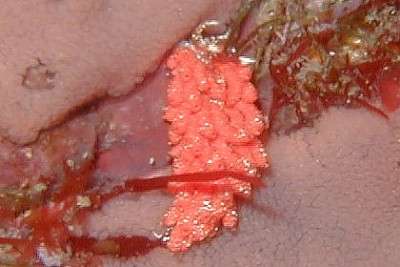
Dear Bill.
Can you please identify this AEOLID sp. from Hachijo Island, Japan.
It was on the egg mass (maybe Hexabranchus sanguineus's egg).
Photographed by me. Length: 20mm, Depth: 26m, Water temperature: 26 degrees.
Sincerely,
Rie
rie@street.ne.jp
Nakano, R., 1999 (Nov 25) Favorinus from Japan. [Message in] Sea Slug Forum. Australian Museum, Sydney. Available from http://www.seaslugforum.net/find/1592Dear Rie,
It is a species of Favorinus and its pink colour is from the eggs it has been eating, which could be of Hexabranchus. In most nudibranchs the colour pattern is quite a good way of identifying species, but in species of Favorinus, which eat other mollusc eggs, much of their colour comes from the eggs they are feeding on. I am afraid it is not possible to be sure of the species unless I could have a closer look at its head and rhinophores which differ in shape between species.
The most likely identification is Favorinus japonicus. There are photos of it already on the Forum showing colour variation.
Best wishes,
Bill Rudman.
